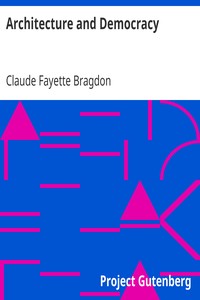Architecture and Democracy by Claude Fayette Bragdon
"Architecture and Democracy" by Claude Fayette Bragdon is a philosophical treatise on architecture written in the early 20th century. This work explores the intricate relationship between architectural forms and the ideals of democracy, emphasizing that architecture reflects the societal consciousness and spiritual condition of the people. The author argues that buildings are expressions of thought, culture, and societal structure, drawing deeply from historical perspectives while also commenting on contemporary architectural practices. The
opening of the text sets the stage by asserting that architecture not only serves practical purposes but also embodies the values and philosophies of the society that constructs it. Bragdon critiques the state of architecture in the United States before World War I, characterizing it as a struggle against the remnants of feudalism, marked by a lack of beauty and disconnected from the ideals of democracy. He introduces key concepts such as the necessity for unity between structural engineering and design, establishing a foundation for the later discussions on how real democracy should inspire organic architectural forms that reflect a higher consciousness and beauty within society. The beginning lays a philosophical groundwork, suggesting that architecture is a living expression of cultural ideals and the collective human spirit. (This is an automatically generated summary.)
Read or download for free
| How to read | Url | Size | |||
|---|---|---|---|---|---|
| Read now! | https://www.gutenberg.org/ebooks/12625.html.images | 253 kB | |||
| EPUB3 (E-readers incl. Send-to-Kindle) | https://www.gutenberg.org/ebooks/12625.epub3.images | 171 kB | |||
| EPUB (older E-readers) | https://www.gutenberg.org/ebooks/12625.epub.images | 172 kB | |||
| EPUB (no images, older E-readers) | https://www.gutenberg.org/ebooks/12625.epub.noimages | 159 kB | |||
| Kindle | https://www.gutenberg.org/ebooks/12625.kf8.images | 302 kB | |||
| older Kindles | https://www.gutenberg.org/ebooks/12625.kindle.images | 285 kB | |||
| Plain Text UTF-8 | https://www.gutenberg.org/ebooks/12625.txt.utf-8 | 235 kB | |||
| Download HTML (zip) | https://www.gutenberg.org/cache/epub/12625/pg12625-h.zip | 169 kB | |||
| There may be more files related to this item. | |||||
Similar Books
About this eBook
| Author | Bragdon, Claude Fayette, 1866-1946 |
|---|---|
| Title | Architecture and Democracy |
| Contents | Architecture and democracy -- Ornament from mathematics -- Harnessing the rainbow -- Louis Sullivan, prophet of democracy -- Color and ceramics -- Symbols and sacraments -- Self-education. |
| Credits | E-text prepared by Leah Moser and the Project Gutenberg Online Distributed Proofreading Team |
| Reading Level | Reading ease score: 51.7 (10th to 12th grade). Somewhat difficult to read. |
| Language | English |
| LoC Class | NA: Fine Arts: Architecture |
| Subject | Decoration and ornament |
| Subject | Architecture |
| Subject | Sullivan, Louis H., 1856-1924 |
| Subject | Architecture -- United States |
| Category | Text |
| EBook-No. | 12625 |
| Release Date | Jun 1, 2004 |
| Most Recently Updated | Oct 28, 2024 |
| Copyright Status | Public domain in the USA. |
| Downloads | 287 downloads in the last 30 days. |
| Project Gutenberg eBooks are always free! | |

